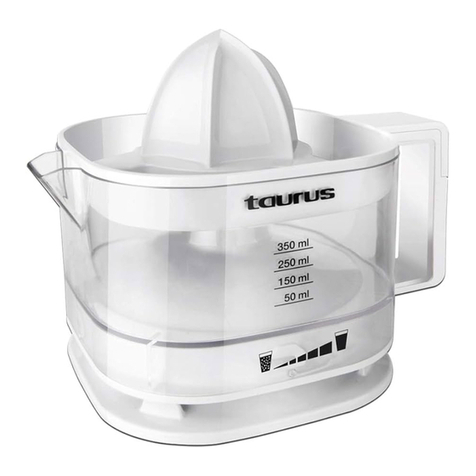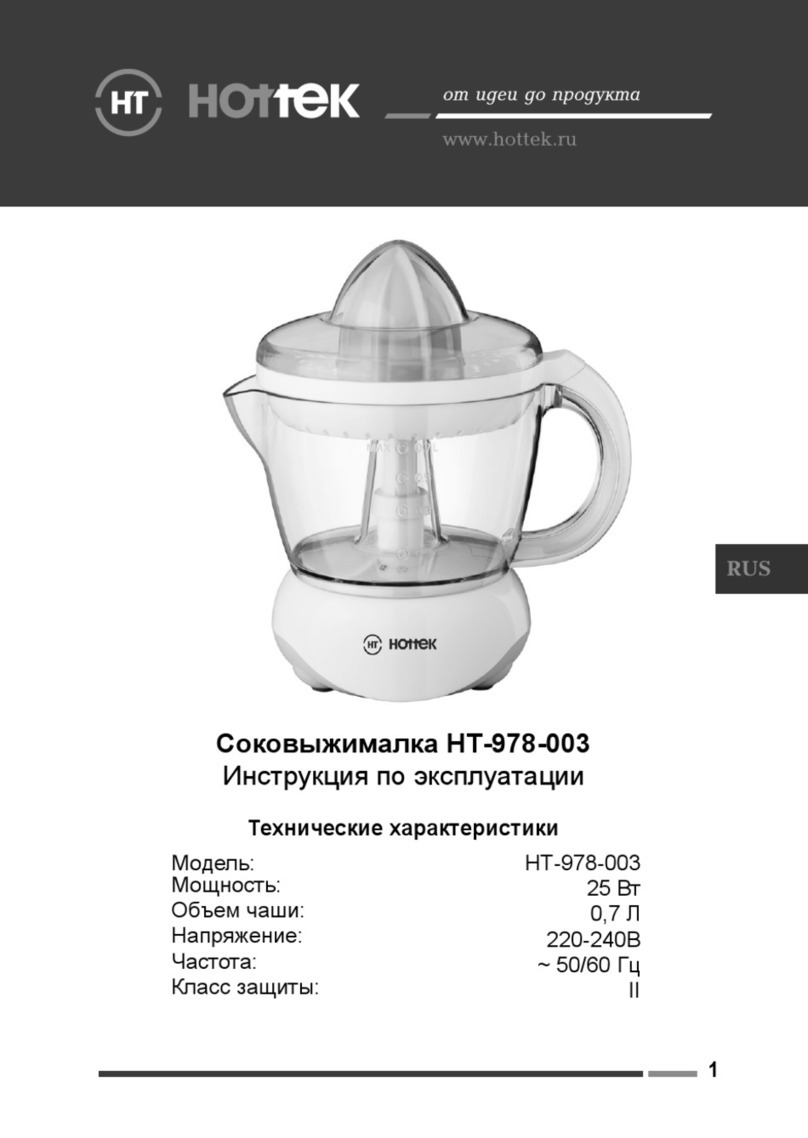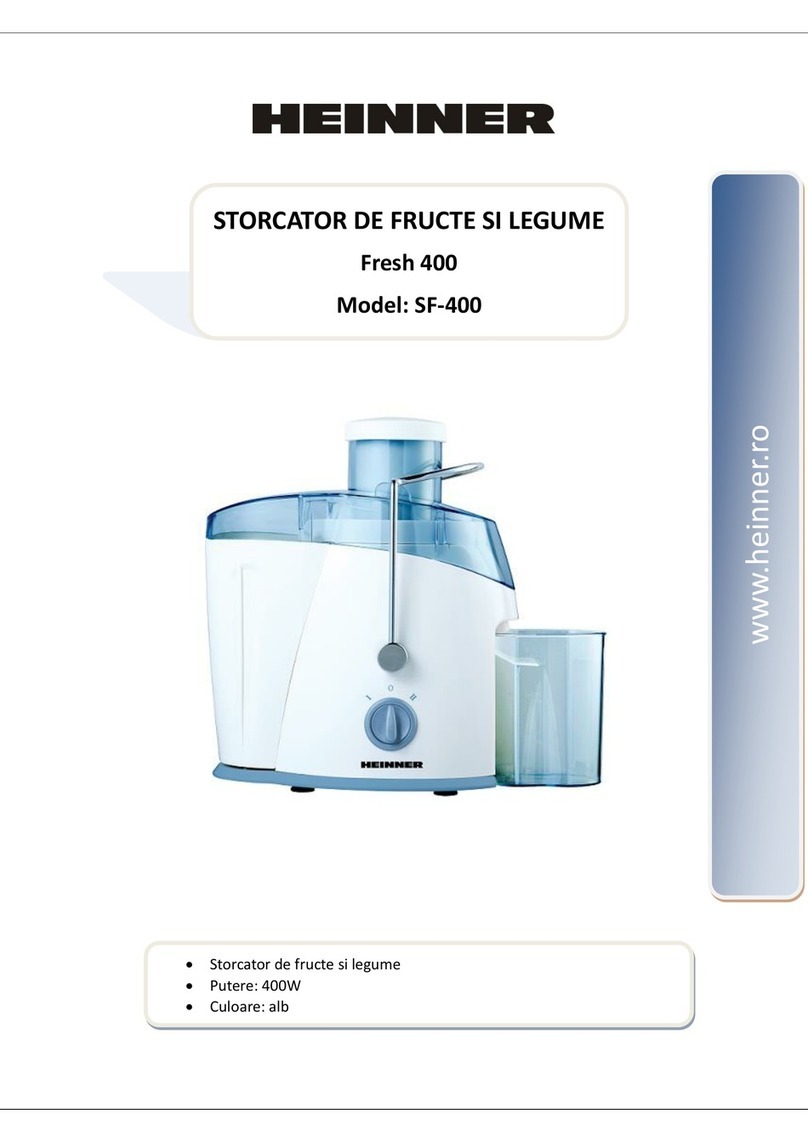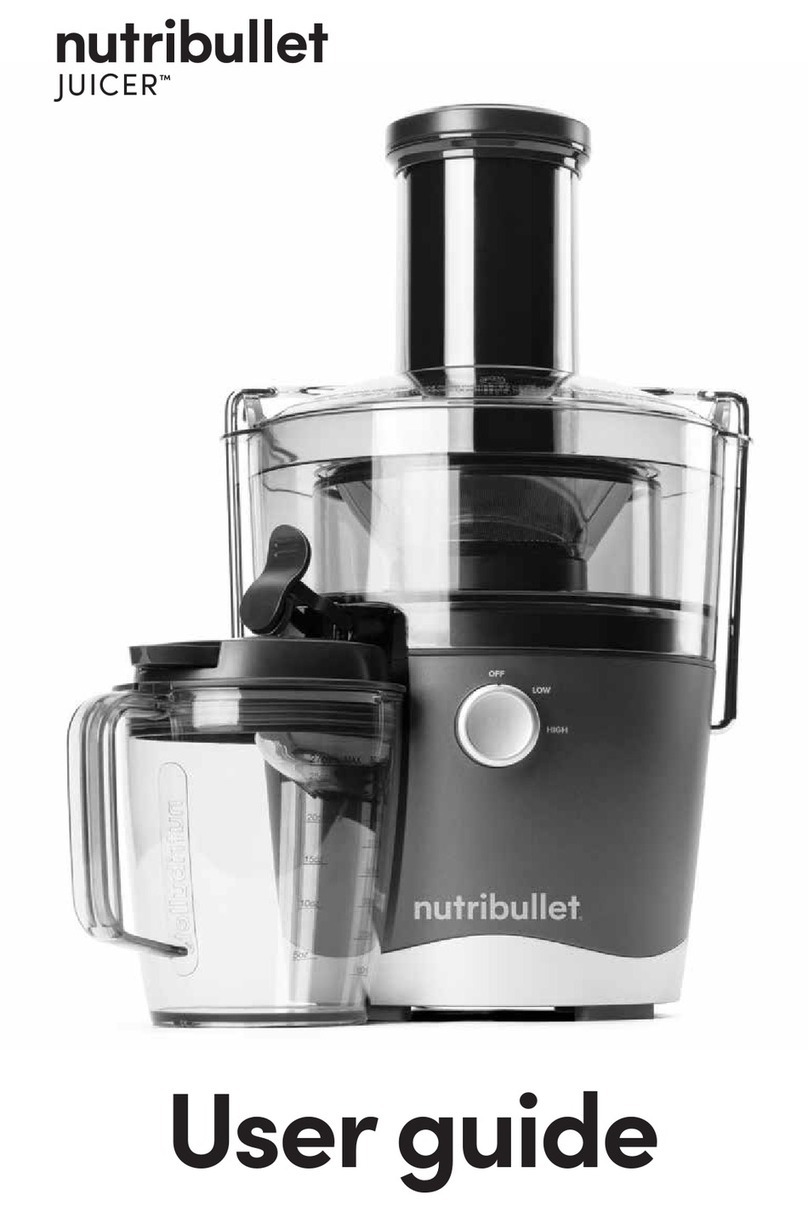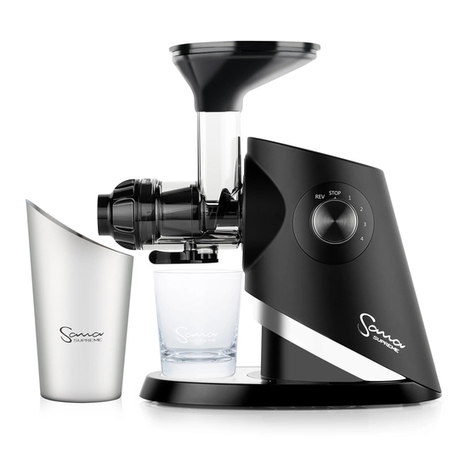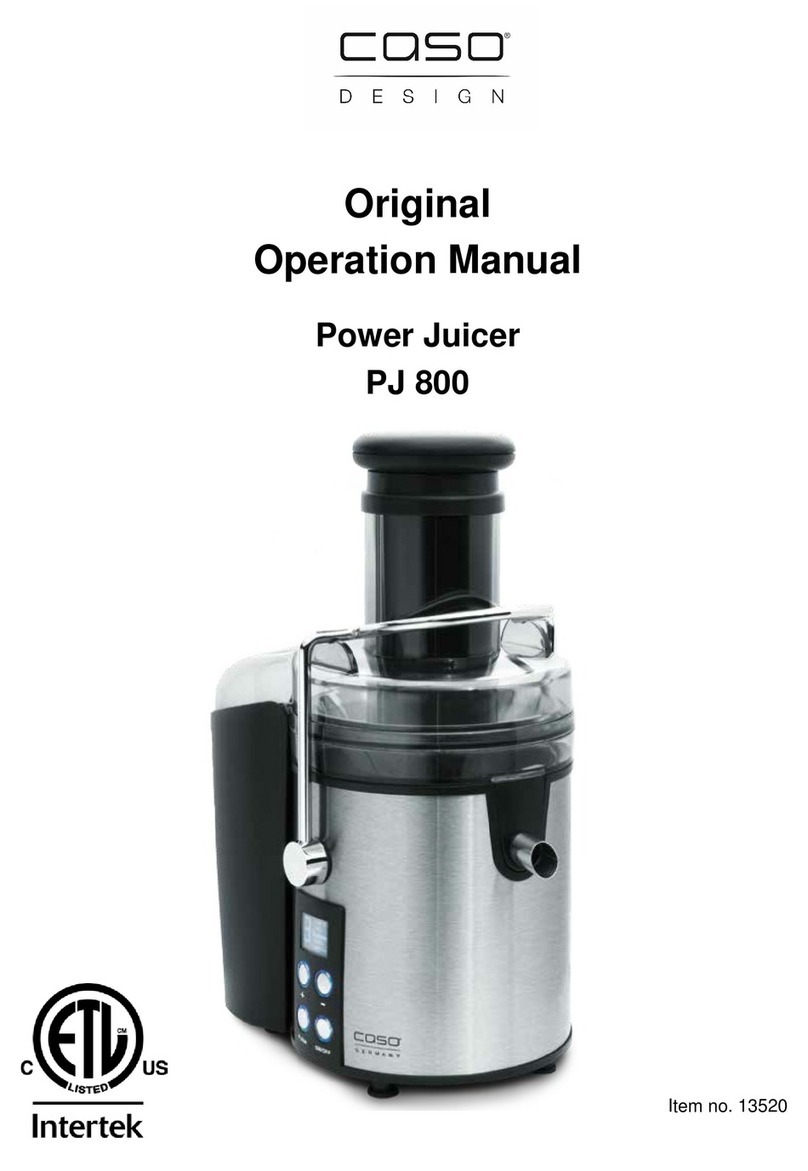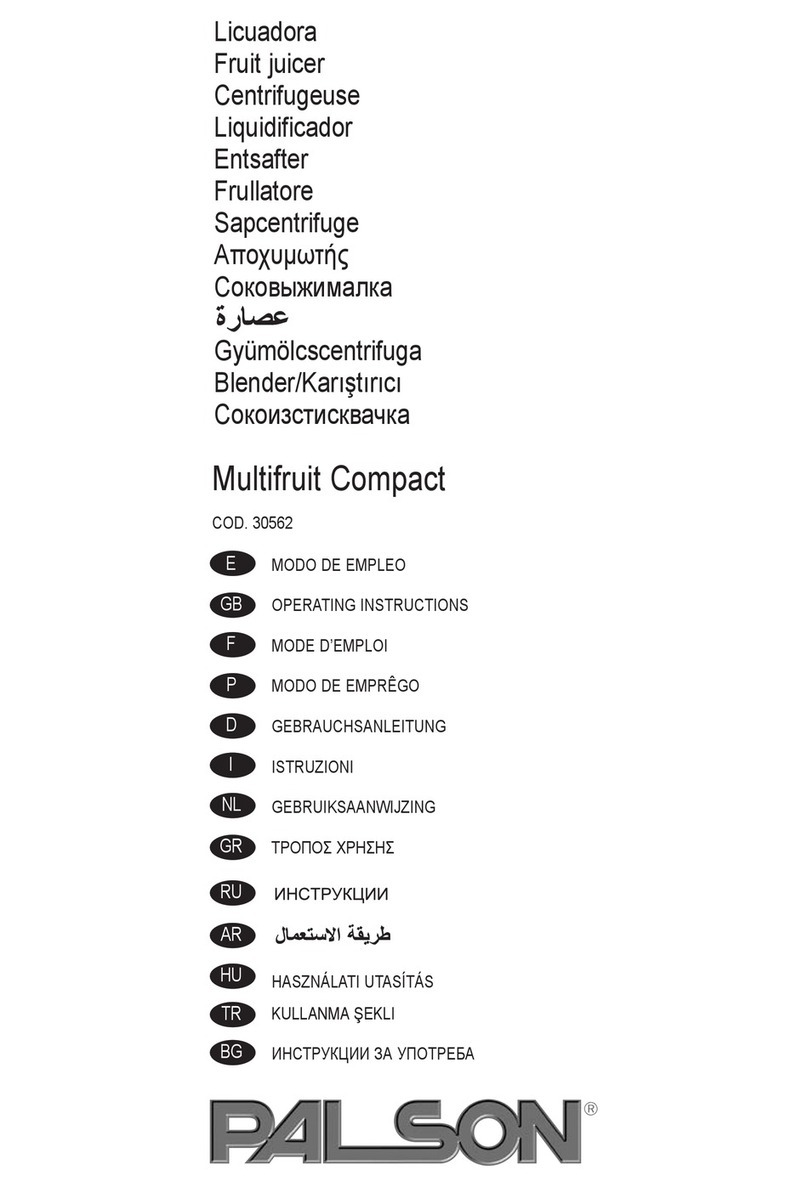Skyfood CSE User manual

Data de Correção: 17/11/2016
UG0183/59030.4 - INGLÊS/ESPANHOL
- BESIDES THIS EQUIPMENT, A COMPLETE RANGE OF OTHER PRODUCTS ARE MANUFACTURED, CONSULT OUR DEALERS
- DUE TO THE CONSTANT IMPROVEMENTS INTRODUCED TO OUR EQUIPMENTS, THE INFORMATION CONTAINED IN THE PRESENT
INSTRUCTION MANUAL MAY BE MODIFIED WITHOUT PREVIOUS NOTICE.
Skyfood Equipament LLC
OFFICE
11900 Biscayne Blvd. Suite 616 - North Miami, FL 33181 - USA
1-800-503-7534 | 305-868-1603
Centrifuge Juicer
CSE
INSTRUCTIONS MANUAL

2
SUMMARY
1. IntroducƟon ......................................................................................3
1.1 Safety .................................................................................................................... 3
1.2 Main Components ................................................................................................. 5
1.3 Technical CharacterisƟcs ........................................................................................ 6
1.4 SelecƟng the Plates................................................................................................ 6
1.5 Plates coming along with the Processor and OpƟonal Plates ................................. 8
1.6 Labels .................................................................................................................... 9
2 InstallaƟon and Pre OperaƟon .......................................................... 10
2.1 InstallaƟon ...........................................................................................................10
2.2 Pre OperaƟon .......................................................................................................12
3. OperaƟon ........................................................................................ 14
3.1 StarƟng.................................................................................................................14
3.2 OperaƟon Procedures...........................................................................................15
3.3 Cleaning and SaniƟzing .........................................................................................16
3.4 CauƟons with Stainless Steel ................................................................................18
4. General Safety PracƟces .................................................................. 20
4.1 Basic OperaƟon PracƟces......................................................................................20
4.2 Safety Procedures and Notes before Turning the Machine ....................................21
4.3 RouƟne InspecƟon................................................................................................22
4.4 OperaƟon .............................................................................................................22
4.5 AŌer Finishing The Work.......................................................................................22
4.6 Maintenance ........................................................................................................23
4.7 Warning................................................................................................................23
5. Analysis and Problems Solving.........................................................24
5.1 Problems, causes and soluƟons ............................................................................24
6. Applicable Norms ............................................................................ 26
7. Electric Diagram............................................................................... 28
47

46
7. Diagrama Elétrico
3
1. IntroducƟon
1.1 Safety
When incorrectly used this equipment is a potenally DANGEROUS machine.
Before using this equipment, read this Instrucons Manual carefully and keep it accessible
for future consulng.
To avoid accidents, injure or damages to the equipment, respect the following instrucons:
1.1.1 In order to avoid the risk of electric shocks and damage to the machine, never operate
it wearing wet clothes or shoes, install the equipment on a wet or humid surface nor dip it
in water or any other liquid, and do not spray water directly on it.
1.1.2 The use of the equipment must be always supervised specially when used next to
children.
1.1.3 Before cleaning and when not in use or before inserng or removing accessories,
maintenance, or other services, disconnect machine from power source.
1.1.4 Do not use the equipment if the cord or the plug is damaged. Do not leave the electric
cable on the edge of the table or counter nor let it touch hot surfaces.
1.1.5 Do not use the equipment if it is not working correctly, nor if it has been damaged in
any way. In case that happens, take the equipment to the nearest Technical Assistance to
check it up.
1.1.6 The use of accessories not recommended by the manufacturer may cause personal
hurt.
1.1.7 Keep your hands or any tool away from the moving parts.
1.1.8 During operaon, never wear loose clothes with wide sleeves principally around the
wrists.
1.1.9 Make sure the equipment voltage is the same as the network voltage and that the
equipment is duly grounded.
1.1.10 Do not use the equipment outdoors.
1.1.11 Do not leave your equipment working without supervision.

4
1.1.12 When performing the electrical installaon of the equipment, connect the
grounding wire according to the local safety norms.
1.1.13 For your safety, the temperature of the processed products must not exceed 40°C.
1.1.14 This equipment has been designed to be used in commercial kitchens, such as:
restaurants, cafeterias, hospitals, bakeries, butcheries and so on.
This equipment is not recommended to be used:
- when connuous industrial producon is necessary.
- work place has a corrosive or explosive atmosphere or it is contaminated with steam,
dust or gas.
IMPORTANT
To provide more safety to the Centrifuge Juicer users, this equipment has an
electronic system that avoids the machine to be turned ON without the Liquid
Chamber Lid (#02 Pic. 01) on its working posiƟon.
45

44 5
IMPORTANT
Make sure the cord is in perfect condiƟons for use. If it is not, change it for a new
one in accordance with the technical specificaƟons and safety rules.
The subsƟtuƟon shall be made by a qualified professional, and shall respect the
local safety norms.
IMPORTANT
This equipment must not be used by children or any persons with reduced
physical or mental aptness, lack of experience or knowledge, unless they are
under supervision or have received from the person responsible for safety proper
instrucƟons on how to use the equipment.
IMPORTANT
Children shall be watched in order to avoid them to play with the equipment.
IMPORTANT
For the operator safety this equipment has a safety system not allowing to be
accidentally started aŌer an eventual electricity failure.
IMPORTANT
In case of emergency, unplug the equipment.
IMPORTANT
Never spray water directly on the equipment.

6
1.2 Main Components
All components are made with carefully selected materials, in accordance with Siemsen
experience and standard tesng procedures.
01– Feeding Throat
02 – Liquid Chamber Lid
03 – Fast Lock
04 – Outlet tube
05 – Motor Housing
06 – ON Switch and OFF Switch
07 – Base
08– Waste Exit Opening
09 - Sieve
10 – Lid Sensor
11 – Liquid Chamber
12 - Cup
13- Stumper
14– Collector Bowl
PICTURE 01
09
10
11
PICTUR
01
05
06
08
01
02
03
04
07
12
13
14
43

42
6. Mantenimiento
El mantenimiento debe ser considerado como un conjunto de procedimientos con el
objevo de conservar el equipo en las mejores condiciones de funcionamiento propiciando
un aumento de su vida úl y de su seguridad.
* Limpieza - verificar el ítem No. 3.3 de este manual.
* Cableado - verifique todos los cables cuanto a su deterioración y todos los terminales
cuanto a su aprieto y corrosión.
* Contactos – Llave prender/apagar, botón de emergencia, botón rearme, circuitos
electrónicos, etc. Verifique el equipo para que todos los componentes estén funcionando
correctamente y que la operación del equipo sea normal.
* Instalación – Verifique la instalación de su equipo de acuerdo con el ítem 2.1 de este
manual.
Vida úl de este equipo- 2 años en turno de trabajo normal
1. verificaciones a ejecutar mensualmente:
. Verificar la instalación eléctrica.
. Controlar la tensión de la toma eléctrica
. Medir la corriente eléctrica y compararla con la corriente nominal
. Verificar el aprieto de todos los terminales eléctricos para evitar malos contactos.
. Verificar posibles holguras del eje del motor eléctrico
. Controlar el cableado eléctrico para idenficar señales de sobrecalentamiento, aislamiento
deficiente o avería mecánica.
2. verificaciones a ejecutar cada tres meses:
.Verificar los componentes eléctricos como la llave prender/apagar el botón de emergencia,
botón rearme, y circuitos electrónicos con respecto a sobrecalentamiento, aislamiento
deficiente o avería mecánica.
. Verificar posibles holguras en los ejes y rodamientos.
. Verificar retenedores, anillos O ‘ring, anillos V’ring, y otros sistemas de vedamiento.
7
2. InstallaƟon e Pre OperaƟon
2.1 InstallaƟon
2.1.1 Placing
Place the equipment on a dry, stable and level surface having a preferenal 850 mm height
above the floor.
850 mm
1.3 Technical CharacterisƟcs
TABLE 01
CHARACTERISTICS UNIT CSE
Rotaon rpm 3500
Voltage V 127 ou 220
Frequency Hz 60
Power rang W 660
Height mm 570
Width mm 600
Depth mm 350
Net Weight kg 13,7
Gross Weight kg 20

8
2.1.2 Electrical Installaon
Before plugging the equipment on the socket, make sure the network voltage is the same
as indicated on the cord label.
The power plug has 3 (three) pins, the middle one is designed to grounding – Ground Pin.
All the 3 (three) pins must be properly connected before operang the equipment.
2.2 Pre OperaƟon
Before using the Centrifuge Juicer, the parts that will be in contact with the product that
will be processed shall be washed with water.
IMPORTANT
Make sure the network voltage where the equipment is going to be installed is the
same as indicated on the cord label.
Assembly Sequence
01
02
03
04
05
01 - Pusher
02 - Liquid Chamber Lid
03 - Sieve
04 - Liquid Chamber
05 - Motor Support Flange
41
TABLA 04
PROBLEMAS CAUSAS SOLUCIONES
El equipo no prende
Procedimiento de accionar
incorrecto
Falta de energía eléctrica
Protector térmico del motor
está actuando
Problemas con el circuito
eléctrico
Leer el ítem 3.1 –
accionamiento
Verifique se hay energía
Aguarde algunos minutos y
tente nuevamente
Llame el servicio técnico
El equipo para o reduce su
velocidad cuando procesa los
alimentos
La correa ene holgura
El disposivo de seguridad de la
Tapa de la Cámara ene falla de
contacto
Problema con el motor eléctrico
Ajustar la tensión de las
correas
Llame el servicio técnico
Llame el servicio técnico
El producto procesado queda
retenido en el interior del
equipo
Hace falta el plato expulsor
Boca de salida obstruida
Coloque el plato expulsor
Desobstruya la boca de salidaa
Corte del producto está
irregular
Las cuchillas han perdido el hilo
o están con daño
Afile las cuchillas o cambie el
disco
Olor de humo o/y quemado Problema en el circuito eléctrico Llame el servicio técnico
Cable eléctrico con daño Falla en el transporte del equipo Llame el servicio técnico
Ruidos anormales Problemas con los rodamientos Llame el servicio técnico

40
Nunca limpie la maquina antes de su PARADA COMPLETA.
Recoloque todos los componentes de la maquina en sus lugares, antes de prenderla otra
vez.
Con frecuencia controle la tensión de las correas o de las cadenas, NO coloque los dedos
entre las correas y las poleas ni entre las cadenas y sus engranajes.
4.6 Mantenimiento
4.6.1 Peligros
Con la maquina prendida cualquier operación de mantenimiento es peligrosa.
DESPRENDALA FÍSICAMENTE DE LA RED ELÉCTRICA, DURANTE TODA LA OPERACIÓN DE
MANTENIMIENTO
IMPORTANTE
Siempre reƟre la flecha de su enchufe en casos de emergencia.
4.7 Avisos
El mantenimiento eléctrico o mecánico debe ser hecho por una persona calificada para
hacer el trabajo.
La persona encargada por el mantenimiento debe cerficarse que la maquina trabaje bajo
condiciones TOTALES DE SEGURIDAD.
5. Análisis y Resolución de Problemas
5.1 Problemas, Causas y Soluciones
Este equipo fue diseñado para necesitar un mínimo de manutención. Sin embargo, pueden
ocurrir algunas irregularidades en su funcionamiento debido al desgaste natural causado
por su uso.
Caso ocurra algún problema verifique la Tabla a seguir, donde están algunas soluciones
recomendadas.
9
3. OperaƟon
3.1 StarƟng
Make sure the Sieve is properly fied in the Central Shaand Liquid Chamber Lid is fixed
by the Fast Lock.
-Put the plug into the socket.
-To start the equipment, just press the “I” Key (#01 Pic.01).
-To turn the equipment OFF, just press the “0” Key (#02 Pic. 01).
-If the Lid is removed from its operang posion with the machine ON, for safety, the
equipment will turn OFF. In case this happens, place the Lid back to its working place, press
the “0” Key and turn the machine ON pressing the “I” Key.
3.2 Feeding Procedures
Before using the equipment, the parts that will be in contact with the product that will
be processed shall be washed with water and neutral soap (see item 3.4 Cleaning and
Sanizing).
Make sure the equipment is firm in its working posion.
IMPORTANT
Before using the equipment, always verify the sieve. If you detect any damage, do
not use the equipment and contact the nearest SIEMSEN technical assistant.
To feed the Centrifuge Juicer, follow the steps bellow:
1.Remove the Stumper from the Feeding Throat located on the Liquid Chamber Lid;
2.Cut the products to be centrifuged in a way they can be introduced in the Feeding
Throat, menoned above;
3.Press the ON Key to start the Centrifuge Juicer;
4.Introduce the pieces into the Feeding Throat and, with the Stumper, press them
gradually down;
5.Aer processing the first load, remove the Stumper and repeat step 4 as many mes as
it is necessary unl all the pieces are processed;
6.Pay aenon to the volume of juice that it is running by the Liquid Chamber nib, for the
juice not to overflow the Cup;
7.With some products, it can happen an obstrucon of the waste exit opening

10
3.3 Safety System
3.3.1 Sensor to monitor the Liquid Chamber Lid
To provide more safety to the users, this Centrifuge Juicers CSE has a sensor that avoids
the machine to be turned ON without the Liquid Chamber Lid on its working posion.
IMPORTANT
This equipment has a security system to guarantee the operator integrity.
The operaƟon of this equipment must be performed as described in the item
“OperaƟon” of this manual. Other procedures to operate this equipment are not
safe and must not be used.
if there is a great quanty of the product to be processed. This can be seen if pieces of
the fruit are going out with the juice or when waste stops falling into the bowl collector
or by the Outlet pipe;
8.In this case, turn the machine OFF (even from the electrical network), loose the Fast
Lock and remove the Liquid Chamber Lid;
9.Remove the waste that is obstrucng the exit, wash the Liquid Chamber Lid with water,
assemble the Lid back in the machine fixing it by the Fast Lock and connue to process
the products;
10.When processing diferente products, all the parts that were in contact with the
previous product must be removed from the machine, cleaned and reinstalled.
3.3.2 Reset System
For your safety, this equipment has a security system that prevents its involuntary operaon
aer an eventual electricity failure.
Aer electricity is reestablished, press the OFF Switch and then press the ON Switch.
IMPORTANT
Never clean the equipment if connected to the electric network. To do so, unplug
it. Before removing the Liquid Chamber Lid, make sure the motor is completely
stopped.
39
4.2.3 Cuidados
El cable de alimentación de energía eléctrica de la maquina, debe tener una sección
suficiente para soportar la potencia eléctrica consumida.
Cables eléctricos que estuvieran en el suelo cerca de la maquina, deben ser protegidos
para evitar corto circuitos.
Los tanques de aceite deben estar siempre llenos. Reponga aceite cuando necesario.
4.3 Inspección de RuƟna
4.3.1 Aviso
Al averiguar la tensión de las correas o de las cadenas, NO coloque los dedos entre las
correas y las poleas, ni entre las cadenas y sus engranajes.
4.3.2 Cuidados
Verifique los motores, correas, cadenas o engranajes y las partes deslizantes o girantes de
la maquina, con relación a ruidos anormales.
Al verificar la tensión de las correas o de las cadenas, sustuya el conjunto, caso alguna
correa, cadena o engranaje, tenga desgaste.
Verifique las protecciones y los disposivos de seguridad para que siempre funcionen
adecuadamente.
4.4 Operación
4.4.1 Avisos
No trabaje con pelo largo, que pueda tocar cualquier parte de la maquina, pues el mismo
podría causar serios accidentes. Manténgalo recogido, ó cúbralo con una gorra o pañuelo.
- Solamente operadores entrenados y calificados pueden operar la maquina.
- Nunca toque con las manos o de cualquier otra manera, partes girantes de la maquina.
- JAMÁS opere la maquina, sin algún de sus accesorios de seguridad.
4.5 Después de Terminar el Trabajo
4.5.1 Cuidados
Al terminar el día de trabajo proceda con la limpieza de la maquina. Para tanto, despréndala
sicamente de la toma.

38
peligroso el piso. Para evitar accidentes, el piso debe estar seco y limpio.
ntes de accionar cualquier comando manual (botones, llaves eléctricas, palancas, etc.)
verifique siempre si el comando es el correcto, o en caso de dudas , consulte este Manual.
Nunca toque ni accione un comando manual (botones, llaves eléctricas, palancas etc.) por
acaso.
Si un trabajo debe ser hecho por dos o más personas, señales de coordinación deben ser
dados antes de cada operación. La operación siguiente no debe ser comenzada sin que la
respecva señal sea dada y respondida.
4.1.3 Avisos
En el caso de falta de energía eléctrica, desligue inmediatamente la llave prende/apaga.
Use solamente óleos lubrificantes o grasas recomendadas o equivalentes. Evite choques
mecánicos, ellos pueden causar fallas o malo funcionamiento. Evite que agua, suciedad o
polvo entren en los componentes mecánicos y eléctricos de la maquina.
-No altere las caracteríscas originales de la maquina.
- No sucie, rasgue o rere cualquier equeta de seguridad o de idenficación.
- Caso alguna esté ilegible o fuera perdida, solicite otra al asistente técnico mas cercano.
- Lea atentamente y con cuidado las equetas de seguridad y de idenficación
- Contenidas en la maquina, así como las instrucciones y las tablas técnicas contenidas en
este manual.
4.2 Cuidados y Observaciones Antes de Prender la Maquina
IMPORTANTE
Lea con atención y cuidado las INSTRUCCIONES contenidas en este Manual, antes
de prender la maquina . CerƟİquese que entendió correctamente todas las
informaciones. En caso de duda, consulte su superior o el Vendedor.
4.2.1 Peligro
Cables o hilos eléctricos con aislamiento dañado, pueden provocar choques eléctricos.
Antes de usarlos verifique sus condiciones.
4.2.2 Avisos
Esté seguro que las INSTRUCCIONES contenidas en este Manual, estén completamente
entendidas. Cada función o procedimiento de operación y de mantenimiento debe estar
perfectamente claro.
El accionamiento de un comando manual (botón, llave eléctrica, palanca, etc.) debe ser
hecho siempre después que se tenga la certud de que es el comando correcto.
11
IMPORTANT
Never clean the equipment if connected to the electric network.
The equipment shall be totally cleaned and sanized:
-Before being used the first me;
-Aer every day’s operaon;
-When it has not been used during a long me;
-Before operang it aer a long period unused.
Some parts of the equipment may be removed for cleaning , such as:
-Stumper;
-Liquid Chamber Lid;
-Liquid Chamber;
-Cup;
-Collector Bowl.
Wash all the parts with water and neutral soap.
There are situaons in which throwing a simple cup with water in the feeding throat with
the machine ON, can sasfactory clean the sieve, lid and liquid chamber.
All the movable parts that were in contact with the processed food must be removed and
cleaned.
Below, we describe the procedure to be followed to remove the removable parts:
1. Turn the machine OFF and unplug it from the socket;
2.Loose the Fast Lock, hold the liquid chambre by the nib and remove the Liquid Chamber
Lid pulling it up;
3.Hold the Sieve with both hands and pull it up. If the Sieve does not leave, turn it
anclockwise and pull it up again.
4.Remove the Liquid Chamber;
5.Wash al the removed parts with running water;
6. To assemble the parts, follow the instrucons on item 2.2 Pre Operaon (Assembling).
To assemble the parts, follow the inverse path.
3.4 Cleaning

12
3.5 CauƟons with Stainless Steel
The Stainless Steel may present rust signs, which are ALWAYS CAUSED BY EXTERNAL
AGENTS, especially when the cleaning or sanizaon is not constant and appropriate.
The Stainless Steel resistance towards corrosion is mainly due to the presence of chrome,
IMPORTANT
Never spray water directly to the equipment.
which in contact with oxygen allows the formaon of a very thin protecve coat.
This protecve coat is formed through the whole surface of the steel, blocking the acon
of external corrosive agents.
When the protecve coat is broken, the corrosion process begins, being possible to avoid
it by means of constant and adequate cleaning.
Cleaning must always be done immediately aer using the equipment. For such end, use
water, neutral soap or detergent, and clean the equipment with a socloth or a nylon
sponge.
Then rinse it with plain running water, and dry immediately with a socloth, this way
avoiding humidity on surfaces and especially on gaps. The rinsing and drying processes are
extremely important to prevent stains and corrosion from arising.
IMPORTANT
Acid soluƟons, salty soluƟons, disinfectants and some sterilizing soluƟons
(hypochlorites, tetravalent ammonia salts, iodine compounds, nitric acid and
others), must be AVOIDED, once it cannot remain for long in contact with the
stainless steel.
37
4.1 PracƟcas Básicas de Operación
4.1.1 Peligros
Algunas partes del accionamiento eléctrico presentan pontos o terminales con altos
voltajes. Cuando tocados pueden ocasionar graves choques eléctricos, o hasta la muerte
de una persona.
Nunca toque un comando manual (botón, llave eléctrica, palancas etc.) con las manos,
zapatos o ropas mojadas, no obedecer esta recomendación, también podrá provocar
choques eléctricos, o hasta la muerte de una persona.
4.1.2 Advertencias
El local de la llave prende/apaga debe ser bien conocido, para que sea posible accionarla a
cualquier momento sin la necesidad de procurarla.
Antes de cualquier manutención desconecte la maquina de la red eléctrica. Proporcione
espacio suficiente para evitar caídas peligrosas. Agua o aceite podrán hacer resbaloso y
IMPORTANTE
Si cualquiera de las recomendaciones no fuera aplicable, ignórela.
4. Nociones Generales de Seguridad
IMPORTANTE
Cualquier Ɵpo de alteración en los sistemas de protección y disposiƟvos de
seguridad del equipo implicarán en serios riesgos a la integridad İsica de las
personas en las fases de operación, limpieza, mantenimiento y transporte del
mismo.
Las Nociones Generales de Seguridad fueran preparadas para orientar y instruir
adecuadamente a los operadores de las maquinas, así como aquellos que serán
responsables por su mantenimiento.
La maquina solamente debe ser entregue al operador en buenas condiciones de uso, al
que el operador debe ser orientado cuanto al uso y a la seguridad de la maquina por el
Vendedor. El operador solamente debe usar la maquina con el conocimiento completo de
los cuidados que deben ser tomados, luego de LEER ATENTAMENTE TODO ESTE MANUAL.

36
Visto que generalmente poseen CLORO en su composición, tales sustancias atacan el acero
inoxidable, causando puntos de corrosión.
Mismo los detergentes ulizados en la limpieza domésca, no deben permanecer en
contacto con el acero inoxidable más de lo necesario, debiendo ser también removidos
con agua y la superficie deberá ser completamente seca.
Uso de abrasivos:
Esponjas o estropajos de acero y cepillos de acero en general, además de rallar la
superficie y comprometer la protección del acero inoxidable, dejan parculas que oxidan
y reaccionan, contaminando el acero inoxidable. Por eso, tales productos no deben ser
usados en la limpieza e higienización. Raspados hechos con instrumentos punagudos o
similares también deberán ser evitados
Principais substâncias que causam a corrosão dos aços inoxidáveis:
Poeiras, graxas, soluções ácidas como o vinagre, sucos de frutas e demais ácidos, soluções
salinas (salmoura), sangue, detergentes (exceto os neutros), parculas de aços comuns,
resíduos de esponjas ou palhas de aço comum, além de outros pos de abrasivos.
13
These substances aack the stainless steel due to the CHLORINE on its composion,
causing corrosion spots (ping). Even detergents used in domesc cleaning must not
remain in contact with the stainless steel longer than the necessary, being mandatory to
remove it with plain water and then dry the surface completely.
Use of abrasives:
Sponges or steel wool and carbon steel brushes, besides scratching the surface
and compromising the stainless steel protecon, leave parcles that rust and react
contaminang the stainless steel. That is why such products must not be used for cleaning
and sanizaon. Scrapings made with sharp instruments or similar must also be avoided.
Main substances that cause stainless steel corrosion:
Dust, grease, acid soluons such as vinegar, fruit juices, etc., saltern soluons (brine),
blood, detergents (except for the neutral ones), common steel parcles, residue of sponges
or common steel wool, and also other abrasives.

14
4.1 Basic OperaƟon Procedures
4.1.1 Dangers
Some areas of the electric device have parts that are connected or have parts connected
to high voltage. These parts when touched may cause severe electrical shocks or even be
lethal.
Never touch manual commands such as switches, buons, turning keys and knobs with
your hands wearing wet clothes and/or wet shoes. By not following these instrucons
operator could be exposed to severe electrical shocks or even to a lethal situaon.
4.1.2 Warnings
* The operator has to be well familiar with the posion of ON/OFF Switch to make sure the
Switch is easy to be reached when necessary.
* Before any kind of maintenance, physically remove plug from the socket.
* Provide space for a comfortable operaon thus avoiding accidents.
* Water or oil spilled on the floor will turn it slippery and dangerous. Make sure the floor
is clean and dry.
* Before using any commands (switch, buons, lever), be sure it is the correct one. In case
of doubt, consult this manual.
* Never touch any manual commands (switch, buons, lever) unadvisedly.
* If any work is to be made by two or more persons, coordinaon signs will have to be
given for each operaon step. Every step of the operaon shall be taken only if a sign has
IMPORTANT
If any recommendaƟon is not applicable to your equipment, please ignore it.
4. General Safety PracƟces
IMPORTANT
Any change in the protecƟon systems and safety devices will during operaƟon,
create serious risks to the operator physical integrity.
The following safety instrucons are addressed to both the operator of the machine as
well as the person in charge of maintenance.
The machine has to be delivered only in perfect condions of use by the Distributor to the
user. The user shall operate the machine only aer being well acquainted with the safety
procedures described in the present manual. READ THIS MANUAL WITH ATTENTION.
35
IMPORTANTE
No uƟlice chorros de agua directamente en el equipamiento.
3.4 Cuidados con los aceros inoxidables
Los aceros inoxidables pueden presentar puntos de “corrosión”, que SIEMPRE SON
PROVOCADOS POR AGENTES EXTERNOS, principalmente cuando el cuidado con la limpieza
o higienización no sea constante y adecuado.
La resistencia a la corrosión del acero inoxidable se debe principalmente a la presencia
del cromo que, en contacto con el oxígeno, permite la formación de una finísima camada
protectora. Esta camada protectora se forma sobre toda la superficie del acero, bloqueando
la acción de los agentes externos que provocan la corrosión.
Cuando la camada protectora sufre un rompimiento, el proceso de corrosión es iniciado,
pudiendo ser evitado a través de la limpieza constante y adecuada.
Inmediatamente después de la ulización del equipamiento, es necesario proceder con
la limpieza, ulizando agua, jabón o detergentes neutros, aplicados con un paño suave o
esponja de nylon. A seguir, enjuagar con agua corriente, se debe enjugar e, inmediatamente
secar, con un paño suave, evitando la permanencia de humedades en las superficies y
principalmente en las grietas.
El enjuague y el secado son extremamente importantes para evitar el aparecimiento de
huellas o corrosiones.
IMPORTANTE
Soluciones ácidas, soluciones salinas, desinfectantes y determinadas soluciones
para esterilizar (hipocloritos, sales de amoníaco tetravalente, compuestos de
iodo, acido nítrico y otros), deben ser EVITADAS por no poder permanecer mucho
Ɵempo en contacto con el acero inoxidable.

34
IMPORTANTE
ReƟre el plugue del enchufe antes de empezar el proceso de limpieza.
El equipamiento debe ser totalmente limpio e higienizado:
-Antes de ser usado por la primera vez;
-Después de la operación de cada día;
-Siempre que no sea ulizado por un periodo prolongado;
-Antes de ponerlo en operación después de un empo de inacvidad prolongado.
Algunas partes del equipamiento pueden ser removidas para limpieza:
-Soquete;
-Tapa de la Cámara de Líquidos;
-Cámara de Líquidos;
-Vaso;
-Valija Colectora.
Lave todas las partes con agua y jabón neutro.
Hay situaciones en que un simple vaso con agua despejado en el bocal de alimentación
con la máquina encendida, ya proporciona una limpieza sasfactoria en la criba, tapa y
cámara de líquidos.
Todas las partes móviles que tuvieron contacto con el producto procesado, deben ser
removidas y limpias.
Abajo, describiremos el procedimiento a ser seguido para la remoción de las partes
móviles:
1.Desligue la máquina y desconecte el plugue del enchufe;
2.Afloje El Cierre Rápido, segura la cámara de líquidos por el pico y rere la Tapa de la
Cámara de Líquidos jalándola para arriba;
3.Segura la Criba con las dos manos y jálela para arriba. Caso la Criba no salga, gírela en el
sendo an-horario y jálela nuevamente para arriba.
4.Rere la Cámara de Líquidos;
5.Lave todas las piezas reradas en agua corriente;
6.Proceda el montaje de las piezas en la máquina, siguiendo las informaciones descriptas
en el ítem 2.2 Pre-Operación (Montaje).
Para montar las partes anteriormente removidas, proceda de manera inversa a la secuencia
de los ítems citados arriba.
3.4 Limpieza
15
been made and responded.
4.1.3 Advices
* In case of power shortage, immediately switch the machine off.
* Use recommended or equivalent lubricants, oils or greases.
* Avoid mechanical shocks, once they may cause damages or bad funconing.
* Avoid water, dirt or dust contact to the mechanical and electrical components of the
machine.
* DO NOT change the standard characteriscs of the machine.
* DO NOT remove, tear offor maculate any safety or idenficaon labels stuck on the
machine. If any labels have been removed or are no longer legible, contact your nearest
dealer for replacement.
4.2 Safety Procedures and Notes before Switching the Machine ON
IMPORTANT
Carefully read ALL INSTRUCTIONS of this manual before turning the machine ON.
Be sure to well understand all the informaƟon contained in this manual. If you
have any quesƟon contact your supervisor or your nearest Dealer.
4.2.1 Danger
An electric cable or electric wire with damaged jacket or bad insulaon might cause
electrical shocks as well as electrical leak. Before use, check the condions of all wires
and cables.
4.2.2 Advices
Be sure to well understand all the informaon contained in this manual. Every operaon
funcon or procedure has to be thoroughly clear.
Before using any commands (switch, buons, lever), be sure it is the correct one. In case
of doubt, consult this manual.
4.2.3 Precauons
The electric cable has to be compable with the power required by the machine.
Cables touching the floor or close to the machine need to be protected against short

16
circuits.
The oil reservoirs have to be filled unl the indicated level. Check and refill if necessary.
4.3 RouƟne InspecƟon
4.3.1 Advice
When checking the tension of the belts or chains, DO NOT insert your fingers between the
belts and the pulleys and nor between the chain and the gears.
4.3.2 Precauons
Check the motor and sliding or turning parts of the machine in case of abnormal noises.
Check the tension of the belts and chains and replace the set when belts or chains show
signs of wearing.
When checking the tension of belts or chains DO NOT insert your fingers between belts
and pulleys, nor between the chains and gears.
Check protecons and safety devices to make sure they are working properly.
4.4 OperaƟon
4.4.1 Warnings
Do not use the machine with long hair that could touch any part of the machine. This might
lead to a serious accident. Tie your hair up well and/or cover it with a scarf.
Only trained or skilled personnel shall operate this machine.
Never touch turning parts with your hands or any other way.
NEVER operate the machine without any original safety devices under perfect condions.
4.5 AŌer Finishing The Work
4.5.1 Precauons
Always TURN THE MACHINE OFF before cleaning by removing the plug from the socket.
Never clean the machine unless it has come to a complete stop.
Put all the components back to their funconal posions before turning the machine ON
again.
33
3.3 Sistema de seguridad
3.3.1 Sensor de Vigilancia de la Tapa de la Cámara de Líquidos
Para proporcionar mayor seguridad a los usuarios la Centrífuga de Jugos CSE posee un
sensor que impide que la máquina sea encendida sin que la Tapa da Cámara de Líquidos
esté en su local de trabajo.
IMPORTANTE
Este equipamiento posee un sistema de seguridad para garanƟzar la integridad del
operador. La operación del equipamiento debe ser conforme el ítem “Operación”
de este manual. Otros procedimientos para operar el equipamiento son inseguros,
en esta condición el equipamiento no debe ser uƟlizado.
caso haya grande candad de producto a ser procesado. Esto podrá ser percibido, cuando
esté saliendo juntamente con el jugo pedacitos de fruta o cuando parar de caer residuos
en la Valija Colectora o por el Tubo de Salida;
8.En este caso, desligue la máquina (inclusive de la red eléctrica), afloje el Cierre Rápido y
rere la Tapa de la Cámara de Líquidos;
9.Rere los residuos que estén obstruyendo la salida, lave la Tapa de la Cámara de
Líquidos en agua corriente, monte la Tapa nuevamente en la máquina fijándola por el
Cierre Rápido y connúe el procesamiento de los productos;
10.Al procesar productos diferentes, todas las piezas que tuvieron contacto con el
producto anterior deben ser reradas de la máquina, limpias y reinstaladas otra vez.
3.3.2 Sistema de An-rearme
Para mayor seguridad del usuario este equipamiento posee un sistema de seguridad que
impide el accionamiento involuntario del mismo después de eventual falta de energía
eléctrica. Después de restablecer la energía eléctrica presione la Llave Desliga y en seguida
presione la Llave Enciende.
IMPORTANTE
Nunca haga limpieza con la máquina encendida a la red eléctrica. Para tanto,
deslígala del enchufe. Antes de reƟrar la Tapa de la Cámara de Líquidos, se
cerƟfique de la completa parada del motor.

32
3. Operación
3.1 Accionamiento
Tenga certeza de que la Criba está perfectamente encajada en el Eje Central y se la Tapa de
la Cámara de Líquidos está fija por el Cierre Rápido.
-Introduzca el plugue del equipamiento en el enchufe.
-Para accionar el equipamiento basta presionar la Llave “I” (Nº1 Fig.05).
-Para desligar el equipamiento basta presionar la Llave “0” (Nº2 Fig. 05).
-Se la Tapa ser removida de la posición de operación con la máquina el funcionamiento,
por seguridad la máquina desligará. Caso esto suceda, posicione nuevamente la tapa en el
lugar de operación, presione la Llave “0” y en seguida encienda la máquina en la Llave “I”.
3.2 Procedimiento para Alimentación
Antes de ulizar el equipamiento, se debe lavar todas las partes que entran en contacto
con el producto a ser procesado, con agua y jabón neutro (lea el ítem 3.4 Limpieza).
Verifique se el equipamiento esta firme en su local de trabajo.
IMPORTANTE
Antes de usar verifique siempre la criba. Se detectar alguna hendidura o daño, no
uƟlice el equipamiento y contacte el asistente técnico SIEMSEN más cerca.
Para alimentar la Centrífuga de Jugos siga los pasos mencionados abajo:
1.Rere el Émbolo del Bocal de Alimentación localizado en la Tapa de la Cámara de
Líquidos;
2.Corte los productos que van a ser centrifugados de forma que puedan ser introducidos
en el Bocal de Alimentación arriba mencionado;
3.Accione la Llave Enciende para encender la Centrífuga de Jugos;
4.Introduzca los pedazos en el Bocal de Alimentación y con el auxilio del Émbolo,
presione gradualmente el mismo para bajo;
5.Después de la primera carga haber sido procesada, rere el Émbolo y repita el paso
no.4 cuantas veces sea necesario hasta procesar todos los pedazos previamente
cortados;
6.Quede atento al volumen de jugo que está escurriendo por el pico de la Cámara de
Líquidos, para que el jugo no transborde por el Vaso;
17
Check the level of oil.
Do NOT insert your fingers in between belts and pulleys nor chains and gears.
4.6 Maintenance
4.6.1 Danger
Any maintenance with the machine in working situaon is dangerous.
TURN IT OFF BY PULLING THE PLUG OFF THE SOCKET DURING MAINTENANCE.
IMPORTANT
Always remove the plug from the socket in any emergency situaƟon.
4.7 Warning
Electrical or mechanical maintenance has to be undertaken by qualified personnel.
The person in charge of maintenance has to be sure that the machine is under TOTAL
SAFETY condions when working.
5. Analyses and Problem Solving
5.1 Problems Causes and SoluƟons
The equipment has been designed to need minimum maintenance, however, some
performance failures may happen due mainly to natural worn out, caused by the use of
the Processor.
If some problems arise with your Processor check Table - 04 below where there are detailed
some possible soluons

18
TABLE 04
PROBLEM CAUSES SOLUTIONS
The equipment does not
switch ON.
Wrong starng procedure.
Motor thermal protecon
turned ON.
Electricity shortage.
Problem with the electric circuit.
Read item 3.1 Starng.
Wait some minutes and try
again.
Check network.
Call Technical Assistance.
The equipment stops or slows
down when processing the
product.
The belt is sliding.
The safety device on the lid
contact is failing.
Problem with the electric motor.
Adjust the belt tension.
Call Technical Assistance.
The processed product
remains inside the equipment.
The expeller dish is missing.
Offload throat obstructed.
Place the dish.
Clean the throat.
Irregular cut. Blunt blades or damaged
blades. Change the plate.
Burnt smell or smoke. Problem with the electric circuit. Call Technical Assistance.
Damaged cord. Problems with equipment
transportaon. Call Technical Assistance.
Abnormal noises. Problem with the bearings. Call Technical Assistance.
31
2.1.2 Instalación Eléctrica
Antes de encender el plugue en el enchufe, verifique la tensión (voltaje) indicada en la
equeta del Cabo de Alimentación.
El cabo de alimentación posee 3 pinos, siendo que el pino central se desna al aterramiento.
Es obligatorio que los tres puntos estén debidamente conectados antes de accionar el
equipamiento.
2.2 Pre-Operación
Antes de usar la Centrífuga de Jugos, se debe lavar las partes que entran en contacto con
el producto a ser centrifugado en agua corriente.
IMPORTANTE
CerƟfique que la tensión de la red eléctrica donde el equipamiento será instalado
es compaƟble con la tensión indicada en la eƟqueta existente en el cabo eléctrico.
Secuencia de Montaje
01
02
03
04
05
01 - Soquete
02 - Tapa de la Cámara de Líquidos
03 - Criba
04- Cémara de Líquidos
05– Empalme Soporte del Motor

30
2. Instalación y Pre Operación
2.1 Instalación
2.1.1 Posicionamiento
Posicione el equipamiento sobre una superficie seca, firme y nivelada, con una altura
preferencial de 850mm.
850 mm
1.3 CaracterisƟcas Tecnicas
CUADRO 01
CARACTERISTICAS UNIDAD CSE
Rotación rpm 3500
Tensión V 127 ou 220
Frecuencia Hz 60
Potencia W 660
Altura mm 570
Largura mm 600
Profundidad mm 350
Peso Líquido kg 13,7
Peso Bruto kg 20
19
6. Maintenance
Maintenance must be considered a set of procedures with the purpose to keep the
equipment best operang condions, therefore increasing the equipment life and safety.
* Cleaning – check item 3,3 Cleaning.
* Wiring - Check all wires regarding deteriorate condions as well as all electric contacts
(terminals) regarding ghtening and corrosion.
*Contacts – ON/OFF switch, emergency buon, reset buon, electronic circuits etc ,
check the equipment in order to assure that all components are correctly working and the
equipment operaon is normal.
* Installaon – make sure the installaon followed item 2.1 instrucons.
* Equipment life span: 2 years if normal working me is performed.
1 – Each month check:
- Check the electrical installaon
- Measure the voltage at the socket
- Measure the working current and match it with the nominal current
- Check the ghtening of all electric terminals to avoid bad contacts
- Check electric motor shaclearance
- Check the wiring for overeang, insulaon failures and mechanical damages.
2 – Each three month checks:
- Check electrical components such as ON/OFF switch, emergency buon, reset buon,
electronic electric circuits , overeang, insulaon failings, or mechanical damages
- Check bearings clearances
- Check retainers, O’rings, V’rings and other seals

20 29
1.2 Principales Componentes
Todos los componentes que incorporan la máquina son construidos con materiales
cautelosamente seleccionados para cada función, dentro de los padrones de testes y de la
experiencia Siemsen.
1 - Bocal de Alimentación
2 - Tapa de la Cámara de Líquidos
3 - Cierre Rápido
4 - Tubo de Salida 5 - Gabinete
6 - Llave Enciende y Llave Desliga
7 - Base
8 - Apertura Salida de Residuos
9 - Criba
10 - Sensor de la Tapa
11 - Cámara de Líquidos
12 - Vaso
13- Soquete
14- Valija Colectora
FIGURA 01
09
10
11
FIGURA 0
05
06
08
01
02
03
04
07
12
13
14
Table of contents
Other Skyfood Juicer manuals
Popular Juicer manuals by other brands
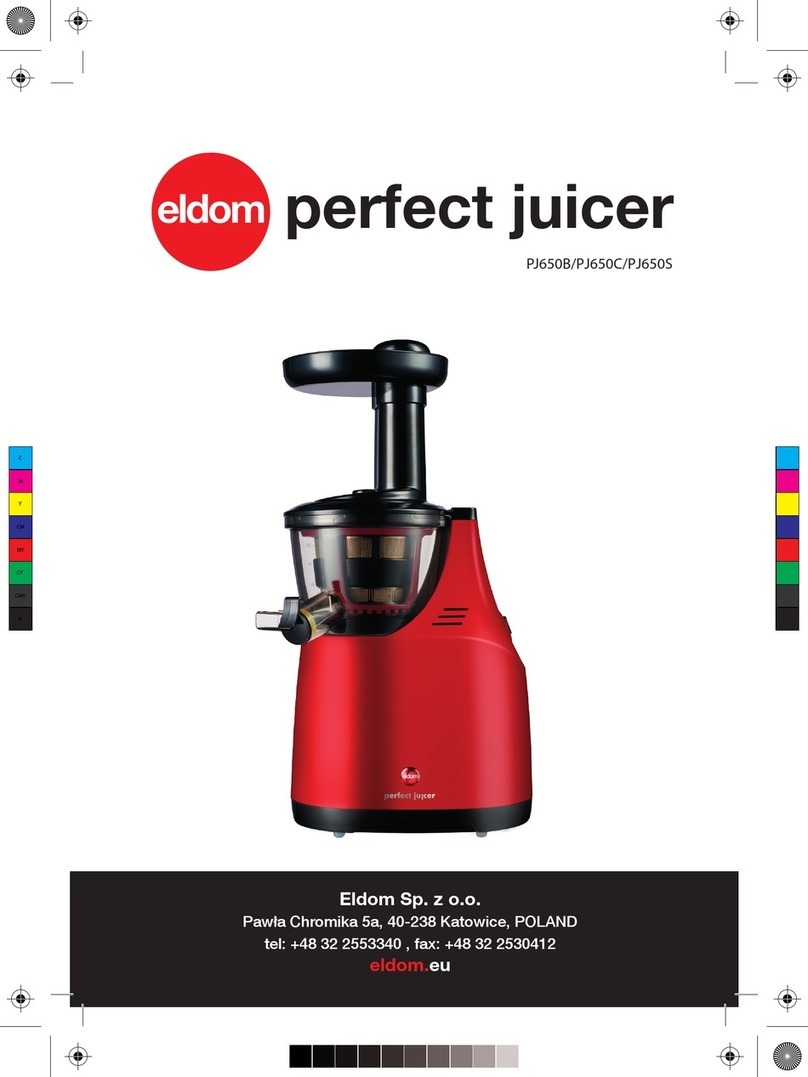
Eldom
Eldom perfect juicer PJ650B operating instructions
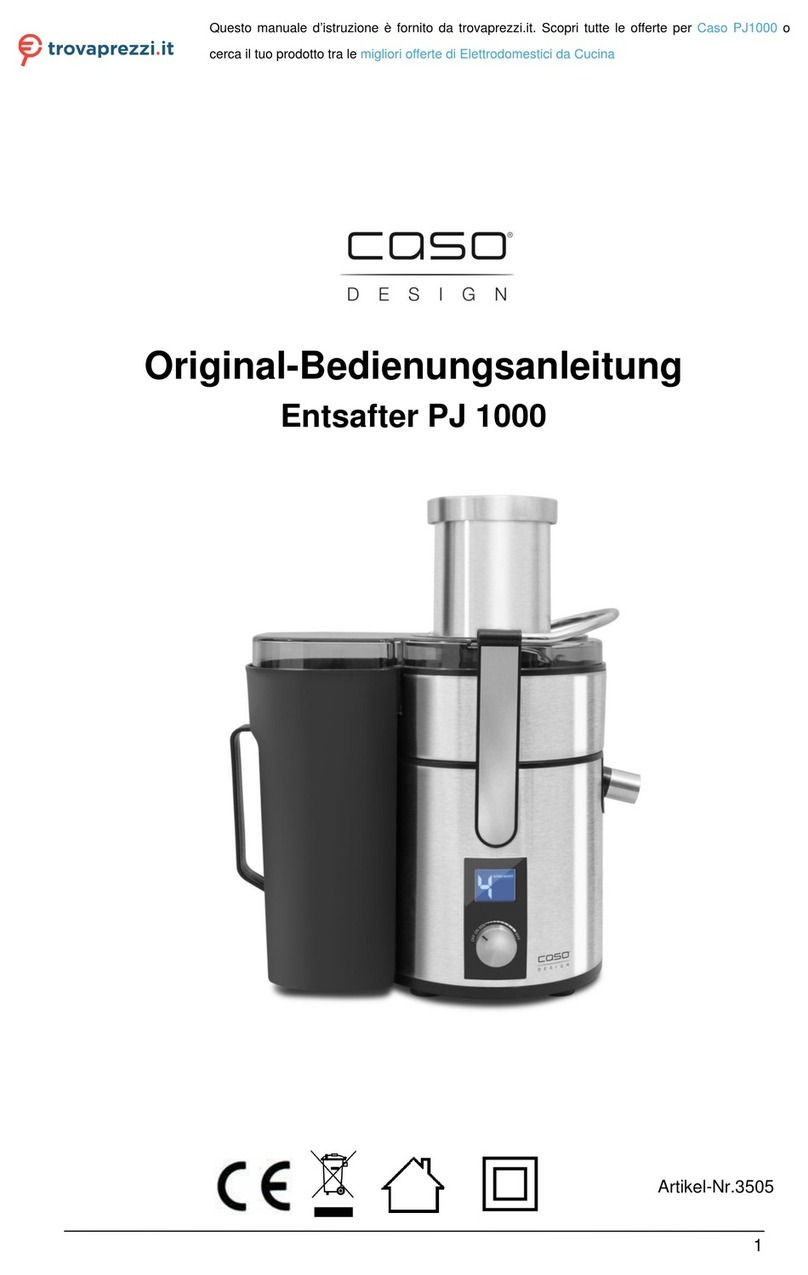
CASO DESIGN
CASO DESIGN 3505 Original operating manual
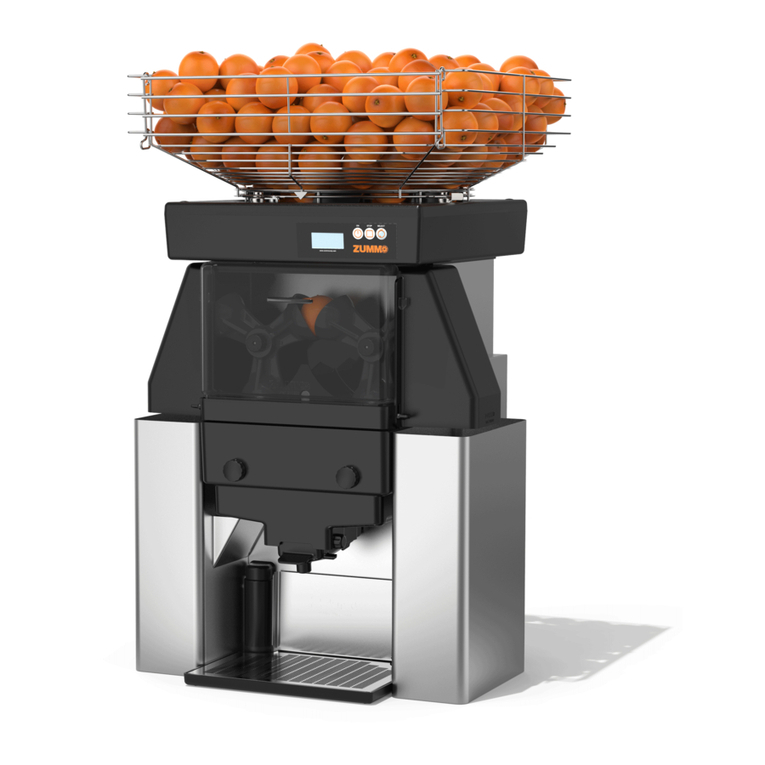
Zummo
Zummo Z40 Technical instructions
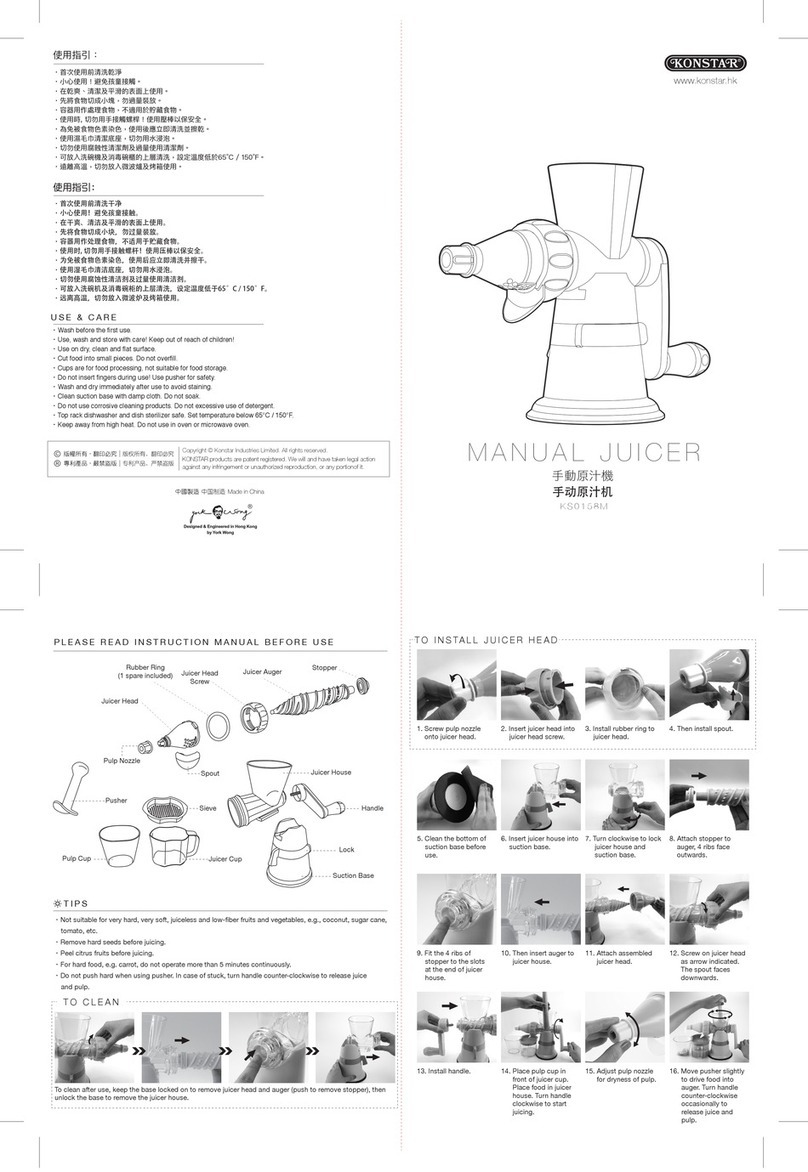
Konstar
Konstar KS0158M instruction manual
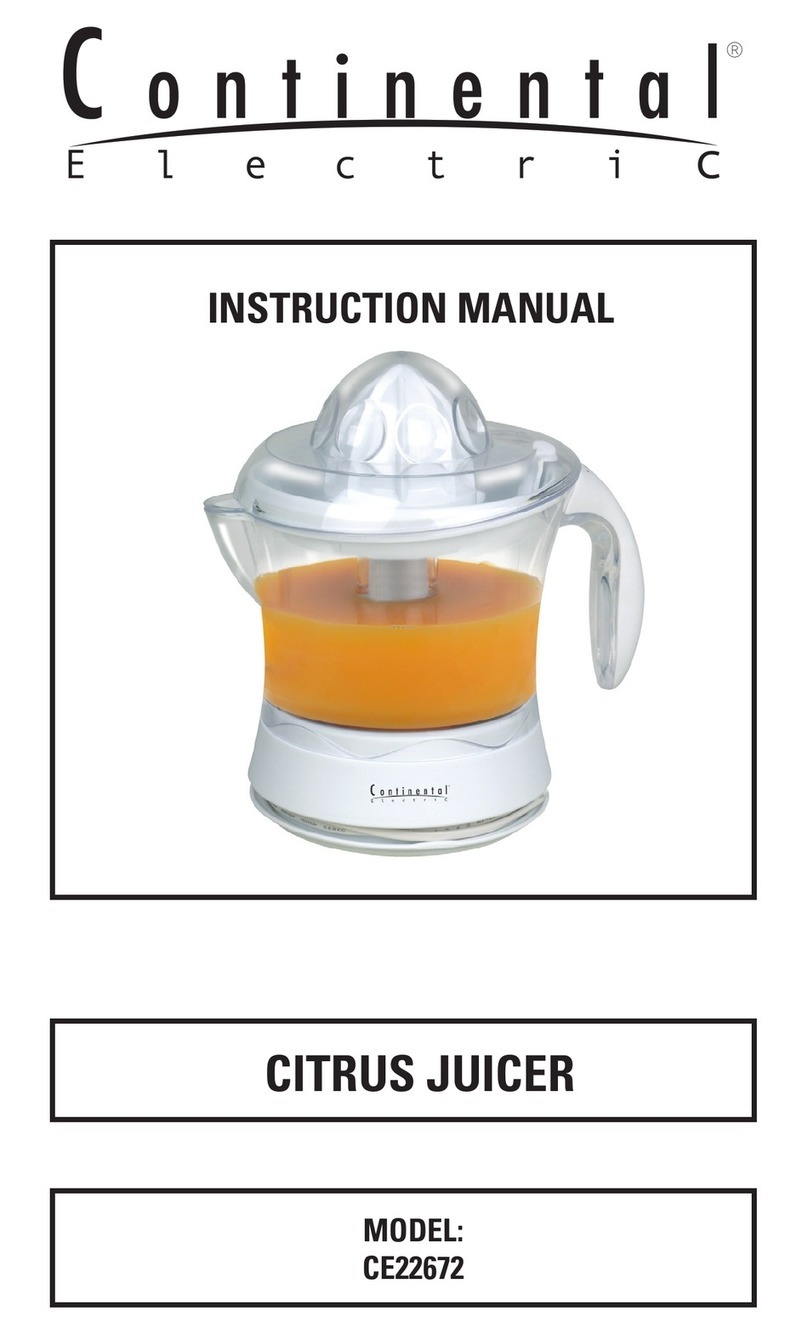
Continental Electric
Continental Electric CE22672 instruction manual
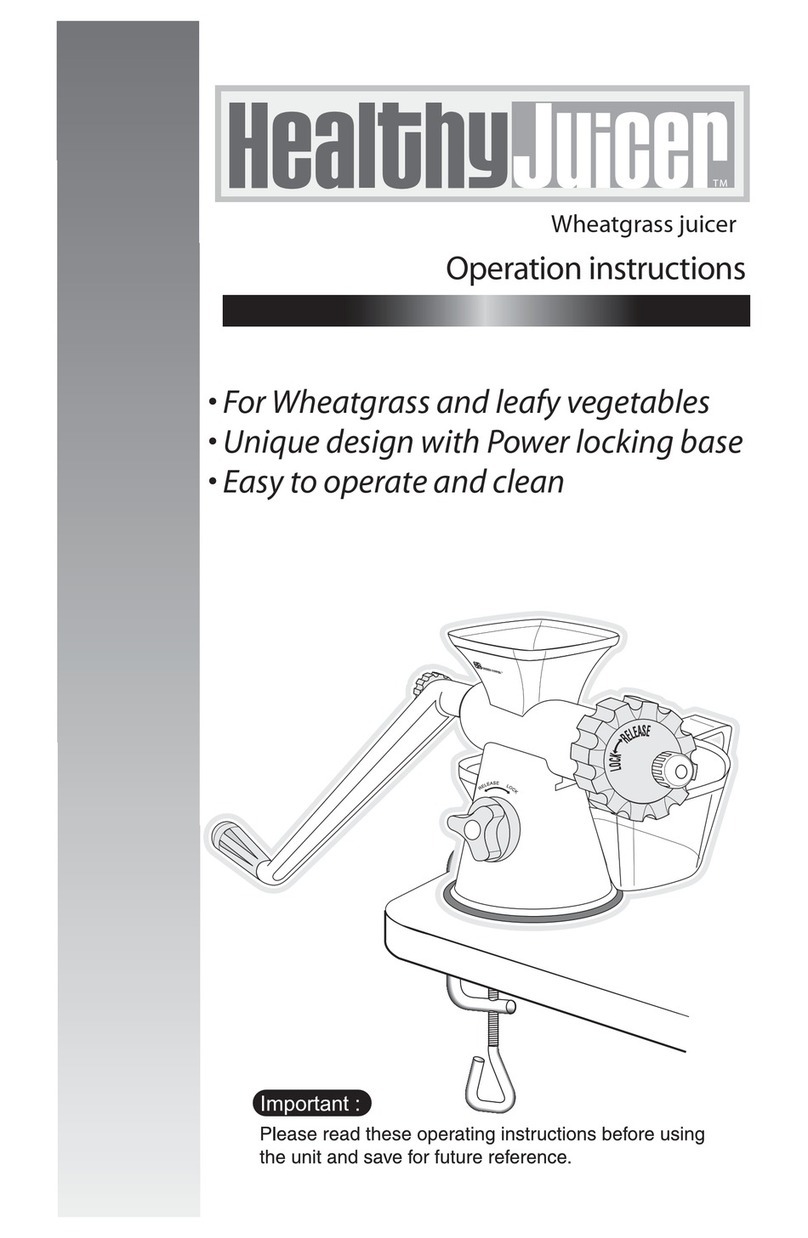
Healthyjuicer
Healthyjuicer Wheatgrass juicer Operation instructions

